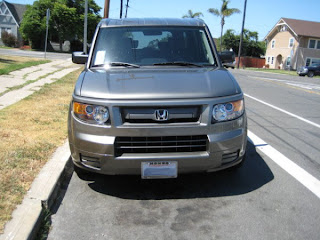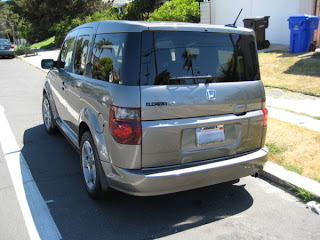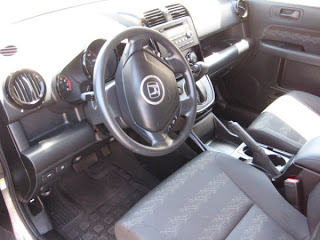25.5 months (with a break), 213 posts (including this one), and one 160 page book of my "best" posts.
My blogging continues at www.joshcanhelp.com.
Thanks for all of your support!
A step-by-step account of my eventual career in the alternative transportation industry. My trials and tribulations and rants and raves and opinions and actions.
25.5 months (with a break), 213 posts (including this one), and one 160 page book of my "best" posts.
Posted with love by
Josh C
0
comments
![]()
A couple cool, cool ones for you...
A junk made of junk (via Cnet):
The activists wanted more people to share their disgust about plastic litter that swirls, relatively unexplored, in continent-size patches of ocean.
To that end, they have built a motor-less craft from 15,000 recycled beverage bottles, fishing nets, and the cockpit of a Cessna, and are sailing it more than 2,000 miles from southern California to Hawaii.
The Dutch have created the Czeers MK1 – the first solar-powered speed boat – which will help bridge a friendship between the love of speed and the love of the environment....Reaching speeds of 30 knots and producing far less noise and pollution than its peers, this boat is 33 feet long and is covered in 150 square feet photovoltaic cells. $1.1 million.
...is fully powered by the integrated solar cells. It is absolutely gorgeous; the deep carbon fiber hue, combined with the orange interiors, and the sleek form give off an incredible James-Bondian vibe. It is also, quite likely, very expensive, as no price has been given, and only a limited number will be produced.
Posted with love by
Josh C
1 comments
![]()
I wanted to share a great riff Seth Godin had about retail packaging. While it doesn't directly have anything to do with transportation, I think you'll find some salient points (and, if you don't, I'll help you out). From Seth's blog:
Item 1: My Logitech cordless remote (which I like a lot) came in plastic, non-recyclable packaging that weighed twice as much as the remote itself.* The plastic was so well sealed and so thick that I actually broke a kitchen knife trying to open it. (*this is not hyperbole. I weighed it).
This is expensive, time-consuming and positions the product as extremely ungreen.
This packaging is the result of a paranoid retail buyer (the person who orders in bulk for the store, not the buyer at retail) demanding pilfer-proof packaging combined with a lazy brand manager choosing a lousy solution to the challenge presented by getting it into a retailer. "Make it pilfer-proof or we won't carry it," he says. The brand manager doesn't want to take a risk, so she packages it the way they packaged it when the device cost $1,000. Impregnable.
When you buy it from Amazon, of course, a cardboard sleeve would be sufficient. The manufacturer, though, only wants to have one sku, so Amazon sells the wasteful one as well.
So, why not compromise and shrink wrap it to a cardboard backad? A simple piece of cardboard, 8 x 10, impossible to fit under your jacket, much lighter, easy to recycle, cheaper and easier to ship.
Posted with love by
Josh C
1 comments
![]()
The 20kw electric motor can achieve a very reasonable 80mph, and will take you on travels up to 100 miles on any given charge. It takes about 6 hours for its lithium-ion battery to recharge fully and, as with most electric vehicles, it comes with a regenerative braking system. The package for all of this three-wheeled fun runs about $20,000 dollars.
VW has been talking for a long time about their L1 concept, so called because it uses a measly 1 liter of gasoline to go 100 km. For us Americans, that translates to about 230 miles per gallon. Of course, the amazing mileage comes at a price. The car is tiny, more of a tobaggon than a car. The single passenger actually sits behind the driver, like in a small airplane.
There are no rear view mirrors and it instead uses cameras and electronic displays. The rear wheels are close together to allow a streamlined body. The drag coefficient (Cd) is 0.159, compared to 0.30 for typical cars.
For light weight, the car uses an unpainted carbon fibre skin over a magnesium subframe. Individual components have been designed for low weight, including engine, transmission, suspension, wheels (carbon fibre), brakes (aluminium), hubs (titanium), bearings (ceramic), interior, and so on. Empty vehicle weight is 290 kg (639 lb).
The body and frame are designed with crush zones and roll-over protection, and the tandem seating means large side crush zones, and Volkswagen claims protection comparable to a GT racing car.
This fall, Mercedes-Benz will offer a new A-Class coupe - the A 160 CDI BlueEFFICIENCY - that gets 52mpg (U.S.). In the NEDC consumption calculation, the car comes in at 4.5 litres of fuel per 100 kilometres and emits just 119 grams of CO2 per kilometer. Those are the best ratings in the A-Class range, and the A 160 CDI BlueEFFICIENCY will still deliver 60 kW/82 hp.

Posted with love by
Josh C
1 comments
![]()
Wow, it only took two days for me to completely miss a day. I'm just not cut out for the heavy blogging.
So, today, I'm putting myself on trial. I bought a new car on Saturday and, if you know me well enough (or have paid attention to key posts) then you know the new ride isn't a Corolla, it isn't a Civic, and it probably isn't a Prius.
I bought a Honda Element.


First, the conversational stuff...
Yes, I love it.
This is a vehicle I've been pining over for a good 5 years or so. For all of you out there who hate them, I hated them too... HATED them. But I rode in one and the owner, a good friend, loved it to death. And then, something in my brain changed and I knew I had to have one. It's everything I want and need in a vehicle in a very unique package.
The GTI had to go.
Poor Gretchen (yes, she has a name) was running a bit rough and had me a bit scared I might be stranded on the side of the road (again). A check engine light and a funny clunk in the front (along with a few other things) made it seem likely that a few thousand in repairs were coming up soon. I drove that picky German b*tch for 9 years and almost 112,000 miles and had very few problems up until about a year ago (maybe a bit before that).
The price was right, the car was right.
This is exactly how I would spec one of these new and there happened to be one on the lot, waiting for me (got there 4 days before I did). Fate?
I guess the big question is why would a green-guy like myself trade UP in vehicle size when I could afford something much smaller and more economical (like a smart [which I briefly considered]). I'll tell you why...
This gets the same MPG.
Yup, that's right, this little guy is rated at the same MPG as my GTI (actually, one less, 23 vs. 24). It's bigger, taller, clearly less aerodynamic, and it's getting about the same. Volkswagens are typically heavier cars and not very fuel efficient (unless they try).
It's an automatic.
Automatics are notoriously better for fuel efficiency because they switch to a high gear when you're not pushing on it. Driving my mom's big SUV around town back home, I found I could squeeze about 25 MPG out of a heavy V6 just because it was automatic (and had a MPG gauge). I find I'm much less aggressive in this car and tend to be about 5mph slower on the freeway; it's just easier to drive at a slower pace.
It can actually fit 4 people.
No more taking two cars because it's too cramped. The 3 other cars I ride around in besides my own are all 2-door and, if they have 4 seatbelts, it doesn't mean 4 adults should be in there.
It takes 87 octane.
And I'm dead sick of spending the money on premium.
So that's the deal.
To be perfectly honest, it was a big issue to buy a new-to-me car that didn't get much better miles-per-gallon. The gas prices are atrocious but my concern is and will continue to be actual consumption, not finances. I know, however, that the difference in overall consumption between 25 mpg and 30 mpg simply isn't enough to justify big sacrifices in my own life.
From spending my own time recycling to this blog to teaching others around me and volunteering for events, I do a lot to affect as many people as possible and, hopefully, convince a few more to make responsible choices. I replaced my bulbs, I control my speed on the freeway, I reuse plastic like a madman, I take cotton bags to the grocery store (when I remember), and I just recently started carpooling with a co-worker. Environmental choices are about more than just a car.
Trust me, I thought this one through. And I'll be the first one with an aftermarket hybrid kit when a solid, tested kit comes out... that or a low-emissions diesel engine from Honda!
Posted with love by
Josh C
2
comments
![]()
First up, great news from Audi via Rueters:
Audi, the luxury unit of Volkswagen, will make cars with no exhaust emissions within ten years, its top executive has told a German weekly. Rupert Stadler told Welt am Sonntag in an interview published on Sunday that he saw great opportunities in electric cars and expected diesel and battery technology to dominate in the coming five to ten years.
.jpg)
Created by noted car designer Henrik Fisker, the ultra cool Karma is a sleek, power packed eco-luxury ride. The Karma’s performance specs rev out at 0-60 mph in 6 seconds, and a top speed of 125 mph. At $80,000 USD, The car is a plug-in hybrid based on technology of Quantum Technologies. The Q DRIVE consists of a small gasoline engine which in turn charges the lithium battery packs in the car. According to Fisker, if charged properly, the hybrid would need to use no more than a fuel tank per year, quite a claim!

Posted with love by
Josh C
2
comments
![]()